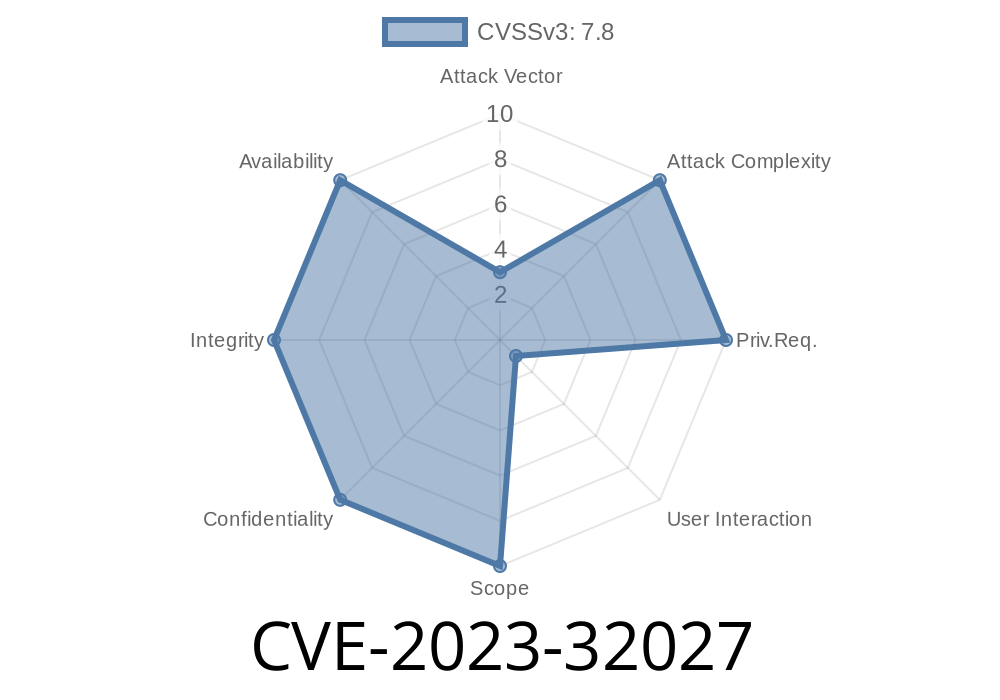In recent times, a critical security vulnerability - CVE-2023-32027 - was discovered in the Microsoft ODBC Driver for SQL Server. This vulnerability could allow attackers to remotely execute malicious code on target systems where the driver is in use. In this post, we will examine this vulnerability, analyze its impact, and briefly discuss possible mitigation techniques. We will also provide code snippets and refer to the relevant original references to provide a holistic understanding of the exploit.
Vulnerability Overview
CVE-2023-32027 is a remote code execution vulnerability in the Microsoft Open Database Connectivity (ODBC) Driver for SQL Server. The vulnerability exists due to improper input validation when processing certain SQL queries. Successful exploitation could allow an attacker to remotely execute arbitrary code with elevated privileges and potentially compromise the target system.
Microsoft ODBC Driver 11 for SQL Server
If you are using one of the above-listed versions, it is crucial to apply the necessary security updates to mitigate this vulnerability.
Exploit Details
The vulnerability exists within the ODBC driver's handling of specific SQL queries. When a malicious SQL query is sent to the target system, the driver fails to properly process the input data and validate the resultant output. As a result, this leads to a buffer overflow condition which ultimately allows the execution of arbitrary code on the target system.
Here is a brief code snippet demonstrating how a malicious SQL query might exploit this vulnerability:
-- Attacker constructs a specially crafted SQL query
DECLARE @MaliciousInput NVARCHAR(400)
SET @MaliciousInput = N'<payload_here>'
-- Specially crafted SQL query executed against the target system
EXEC sp_executesql @Query = N'SELECT * FROM Users WHERE Username LIKE ''%'' + @Input + ''%''', @Parameters = N'@Input NVARCHAR(255)', @Input = @MaliciousInput
This code snippet shows a simple example of how an attacker might use a carefully crafted SQL query to exploit the input validation vulnerability in the Microsoft ODBC Driver for SQL Server.
Original References
To gain a deeper understanding of this vulnerability, it is essential to refer to the original advisories and resources provided by Microsoft and other security organizations. Some key resources include:
1. CVE-2023-32027 - Microsoft Security Response Center (MSRC) Advisory
2. Common Vulnerabilities and Exposures (CVE) - CVE Details of CVE-2023-32027
3. Microsoft's Official Documentation on ODBC Driver for SQL Server
Mitigation Techniques
The most straightforward way to mitigate this vulnerability is to ensure that you are using the latest version of the Microsoft ODBC Driver for SQL Server and apply any available security updates. Microsoft has released updates for affected versions, which can be downloaded from the Microsoft Download Center or obtained through Windows Update.
Additionally, you should follow secure coding practices to validate user input and protect against SQL injection attacks. Input validation should be carried out at both the client-side and server-side to minimize the possibility of exploitation.
Conclusion
CVE-2023-32027 is a high-priority security vulnerability that could potentially allow remote code execution on systems using the affected versions of the Microsoft ODBC Driver for SQL Server. It is vital to apply the recommended security updates and adhere to best coding practices to prevent potential exploits. By staying cautious and informed, you can protect your systems against such vulnerabilities and safeguard your valuable data.
Timeline
Published on: 06/16/2023 01:15:00 UTC
Last modified on: 06/16/2023 03:19:00 UTC
